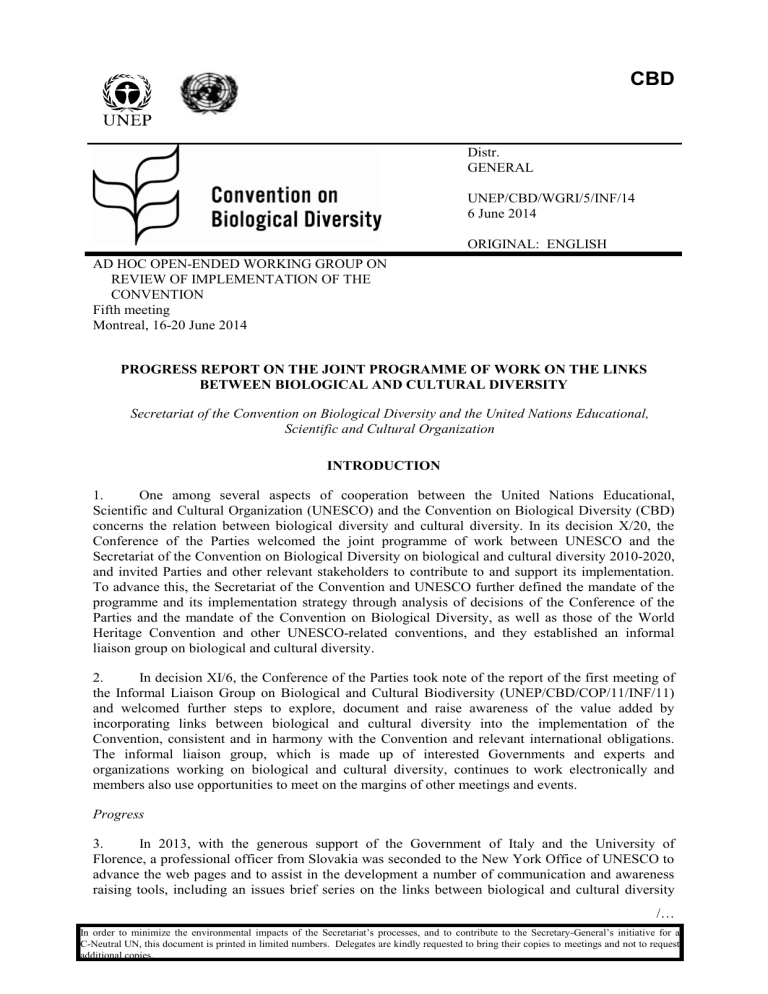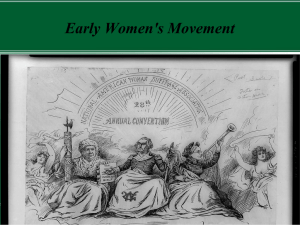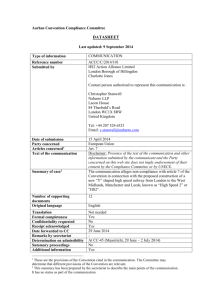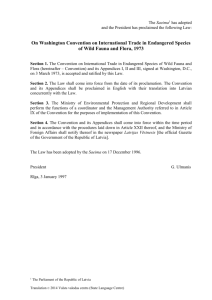ITEM 4. Closure of the meeting - Convention on Biological Diversity

CBD
Distr.
GENERAL
UNEP/CBD/WGRI/5/INF/14
6 June 2014
ORIGINAL: ENGLISH
AD HOC OPEN-ENDED WORKING GROUP ON
REVIEW OF IMPLEMENTATION OF THE
CONVENTION
Fifth meeting
Montreal, 16-20 June 2014
PROGRESS REPORT ON THE JOINT PROGRAMME OF WORK ON THE LINKS
BETWEEN BIOLOGICAL AND CULTURAL DIVERSITY
Secretariat of the Convention on Biological Diversity and the United Nations Educational,
Scientific and Cultural Organization
INTRODUCTION
1. One among several aspects of cooperation between the United Nations Educational,
Scientific and Cultural Organization (UNESCO) and the Convention on Biological Diversity (CBD) concerns the relation between biological diversity and cultural diversity. In its decision X/20, the
Conference of the Parties welcomed the joint programme of work between UNESCO and the
Secretariat of the Convention on Biological Diversity on biological and cultural diversity 2010-2020, and invited Parties and other relevant stakeholders to contribute to and support its implementation.
To advance this, the Secretariat of the Convention and UNESCO further defined the mandate of the programme and its implementation strategy through analysis of decisions of the Conference of the
Parties and the mandate of the Convention on Biological Diversity, as well as those of the World
Heritage Convention and other UNESCO-related conventions, and they established an informal liaison group on biological and cultural diversity.
2. In decision XI/6, the Conference of the Parties took note of the report of the first meeting of the Informal Liaison Group on Biological and Cultural Biodiversity (UNEP/CBD/COP/11/INF/11) and welcomed further steps to explore, document and raise awareness of the value added by incorporating links between biological and cultural diversity into the implementation of the
Convention, consistent and in harmony with the Convention and relevant international obligations.
The informal liaison group, which is made up of interested Governments and experts and organizations working on biological and cultural diversity, continues to work electronically and members also use opportunities to meet on the margins of other meetings and events.
Progress
3. In 2013, with the generous support of the Government of Italy and the University of
Florence, a professional officer from Slovakia was seconded to the New York Office of UNESCO to advance the web pages and to assist in the development a number of communication and awareness raising tools, including an issues brief series on the links between biological and cultural diversity
/…
In order to minimize the environmental impacts of the Secretariat’s processes, and to contribute to the Secretary-General’s initiative for a
C-Neutral UN, this document is printed in limited numbers. Delegates are kindly requested to bring their copies to meetings and not to request additional copies.
UNEP/CBD/WGRI/5/INF/14
Page 2 and an online Global Biological and Cultural Diversity Platform designed to provide policymakers with resources, case studies and tools to integrate the links between biological and cultural diversity in the design and implementation of strategies and policies addressing the erosion and loss of biological and cultural diversity. The web pages for the joint programme were launched in April
2014, in Florence, and work continues with liaison group members to ensure the web pages are a useful living tool for policymakers and others. In particular, partners are submitting case studies, in a searchable format, that illustrate lessons learned on the links between biological and cultural diversity, in various regional contexts.
4. In April 2014, the Government of Italy and the University of Florence, in partnership with the
Secretariat of the Convention on Biological Diversity and the United Nations Educational, Scientific and Cultural Organization initiated the 1st European Conference for the Implementation of the
UNESCO-CBD Joint Programme on Biological and Cultural Diversity to explore the linkages between biological and cultural diversity and cultural landscapes in the European context. The event included a two-day open scientific conference followed by a two-day expert meeting. This initiative provided regionally specific advice in the form of a declaration for consideration by Governments, and regional and international organizations within Europe. As this event was a considerable and substantive contribution to the joint programme of work, a copy of the report is attached as an annex to the current document.
5. Additionally in 2014, with the financial support of the Japan Biodiversity Fund, four regional capacity-building workshops, for indigenous and local communities and national focal points for traditional knowledge and customary sustainable use, were facilitated in the Latin America and
Caribbean region (Bolivia, December 2013), African region (Kenya, April 2014), Asian region
(Thailand, June 2014) and Pacific region (Samoa, August 2014). Seizing the opportunity, the
Secretariat included an agenda item on the joint programme, to raise awareness and garner further regionally specific advice regarding the identification of case studies and the development of tools for policymakers.
Next steps
6. The various regional discussions, including the Florence conference, will contribute to a full day event on biological and cultural diversity for the implementation of the Strategic Plan for
Biodiversity 2011-2020 and the Aichi Biodiversity Targets, to be held in the margins of the twelfth meeting of the Conference of the Parties, on Saturday 11 October 2014.
7. Lessons learned from the joint programme will be integrated into relevant capacity-building opportunities for national focal points and indigenous and local communities in future workshops and will also contribute the further development of the web pages and tools for policymakers.
/…
UNEP/CBD/WGRI/5/INF/14
Page 3
Annex
REPORT OF THE FIRST EUROPEAN CONFERENCE FOR THE IMPLEMENTATION OF
THE UNESCO-CBD JOINT PROGRAMME ON THE LINKAGES BETWEEN CULTURAL
AND BIOLOGICAL DIVERSITY
Linking Biological and Cultural Diversity in Europe
8-11 April 2014,
Florence, Italy
Background
1. In the context of the UNESCO-CBD joint programme between the United Nations
Educational Scientific and Cultural Organization and the Secretariat of the Convention on Biological
Diversity on the links between biological and cultural diversity launched in 2010, UNESCO and
SCBD collaborated with various partners during 2013-2014, in planning a series of regional workshops and conferences in the African, Asian, European, Pacific, and Latin American and the
Caribbean regions.
2. Thanks to the Italian Ministry of Agriculture, Food and Forestry Polices, the Regional
Government of Tuscany and the Research Unit for the Management of Landscape and Rural Heritage of the University of Florence, the 1st European Conference for the Implementation of the UNESCO-
CBD Joint Programme on Biological and Cultural Diversity took place in Florence, Italy from
8 to 11 April 2014. The conference focused on understanding the links between biological and cultural diversity from the European perspective.
3. Other regional discussions were conducted within the framework of capacity-building workshops for indigenous and local communities and national focal points for traditional knowledge
(Article 8(j) and related provisions) facilitated by the Secretariat of the Convention on Biological
Diversity in the Latin American and Caribbean region (Bolivia, December 2013), the African region
(Kenya, April, 2014), and the Asian region (Thailand, May 2014), and the Pacific region (Samoa,
August 2014), under the agenda item on exploring the interlinkages between biological and cultural diversity, and possible implications for policymakers. These workshops were kindly funded by the
Government of Japan.
4.
The outcomes of the regional discussions will feed into a full day’s discussion on the links between biological and cultural diversity and possible contributions to the effective implementation of the revised Strategic Plan for Biodiversity 2011-2020 and the Aichi Biodiversity Targets, being planned for Saturday, 11 October 2014, as a parallel event at the twelfth meeting of the Conference of the Parties to the Convention on Biological Diversity, to be held from 6 to 17 October, 2014,
Pyeongchang, Republic of Korea.
Organization
5. The 1st European Conference for the Implementation of the UNESCO-CBD Joint
Programme on Biological and Cultural Diversity was a joint initiative by the Secretariat of the
Convention on Biological Diversity, UNESCO, the Research Unit for the Management of Landscape and Rural Heritage and the Research Group on Forest History and Traditional Knowledge of the
International Union of Forest Research Organizations (IUFRO). The main sponsors of the event were the regional government of Tuscany (Department of Agriculture and Forestry) and the Italian
Ministry of Agriculture, Food and Forestry Policies. The conference was organized into a two and a half day of scientific/academic conference with parallel sessions and one and a half day of expert meeting dedicated to draft the final declaration.
/…
UNEP/CBD/WGRI/5/INF/14
Page 4
6. The report of the meeting herein is made available as an information document to the fifth meeting of the Ad Hoc Open-ended Working Group on Review of Implementation of the Convention and to the twelfth meeting of the Conference of the Parties to the Convention on Biological Diversity
(COP-12). The declaration arising from the conference, hereafter referred to as the Florence
Declaration , appears in the annex to this report.
INTRODUCTION
7. The relationship between biological and cultural diversity or biocultural diversity and the rural territory is considered as one of the most important perspectives for the implementation of the joint programme between UNESCO and the Secretariat of the Convention on Biological Diversity on biological and cultural diversity 2010-2020. The scientific and policy dimensions of the UNESCO-
CBD joint programme between the United Nations Educational Scientific and Cultural Organization and the Secretariat of the Convention on Biological Diversity on the links between Biological and
Cultural Diversity are of utmost importance in the European context where cultural, environmental and rural policies are devoted to the conservation of biological and cultural heritage, but rarely focused on the features and the effects of the interactions between nature and culture. Yet, throughout
European history, the outcomes of such interactions, including through traditional farming and forestry practices, have been critical for creating resilient landscape patterns, diversifying biological and cultural resources and shaping the cultural identity of different European subregions.
8. Several international scientific organizations and the United Nations have designated landscape as one of the primary concerns of upcoming sustainability policies. The quality of
European landscapes and the associated quality of life is determined by the tight interplay between their economic, social and cultural aspects, through time and space and is often grounded in specific landscapes features. The preservation of such features contributes towards the economic development of the rural territory and local livelihoods, the environmental quality, the quality of life for local populations through both material and immaterial means.
9. Conservation of complex landscape patterns that reflect the identity of different regions, their historical management practices and related biological and cultural diversity need to be ensured through integrated planning and management strategies also as a way of adapting to change. It is also important to develop integrated strategies that will engage the public, owners and local administrations for the recovery, preservation and maintenance of the linkages between cultural and biological diversity reconnecting rural to urban areas and contributing to the well-being of the entire population.
10. More research focusing on the links between cultural and biological diversity at the landscape level is also needed. This is an important task as these links are rarely being formalized from a scientific perspective, therefore knowledge about them has often been ignored or lost. This has led not only to a separation between nature and culture in policies, but also between science and humanities in the study and management of natural and cultural values, affecting the conservation of cultural heritage as well as the natural heritage.
Main objectives and organization of the conference
11. The main objectives of the conference were:
To define the interactions between cultural and biological diversity and to identify links between cultural and biological diversity, in the European context.
To explore the historical development of biodiversity patterns associated with “natural” and
“cultural” landscapes, including interactions between actors, factors and processes.
To consider traditional agricultural and forest management practices related to biocultural diversity. To develop methods and approaches for the assessment of the links between biological and cultural diversity and the resulting “biocultural” diversity.
/…
UNEP/CBD/WGRI/5/INF/14
Page 5
To identify, develop and promote integrated management strategies at landscape level.
To assist in the implementation of international, regional and national agreements dealing with biological and cultural diversity.
Outcomes
12. The outcomes of the conference were:
- The conference presented high quality scientific papers to be published in a book by Springer
Verlag, as well as in a scientific journal issue, as a resource for academics and policymakers and the general public.
- The conference has produced the Florence Declaration on the Links between Cultural and
Biological Diversity summarizing possible goals and strategies for implementing the joint programme in the European context.
- The outcomes will be presented, along with other regional perspectives, to the full day’s discussion at COP-12 on the contribution of biological and cultural diversity to the implementation of the Strategic Plan for Biodiversity 2011-2020.
Attendance
13. After the publication of the call for papers, the scientific committee (SC) has received 165 paper proposals. The selection operated by the scientific committee has accepted 63 papers considered highly relevant for the topic of the conference and 11 posters from 25 countries. The expert meeting for the drafting of the final declaration was attended by 42 experts from 14 countries.
14. The following countries and institutions were represented in the expert meeting: University of Florence; International Union for Conservation of Nature (IUCN); UK Joint Nature Conservation
Committee; Swiss Federal Research Institute WSL, Birmensdorf, Switzerland; Diversidad y
Desarrollo, Morocco-Spain; Global Diversity Foundation; International Society of Ethnobiology;
European University Institute, Florence, Italy; International Fund for Agricultural Development
IFAD; the Food and Agriculture Organization of the United Nations (FAO); Hungarian Open Air
Museum, Szentendre, Hungary; Ministry of Agricultural, Food and Forestry Policies of Italy;
CIVILSCAPE; German forum for cultural landscapes, Bund Heimat und Umwelt, Germany;
Metsähallitus Forestry Land and Protected Areas, Finland; International Union of Forest Research
Organization; ICOMOS; Stockholm Resilience Centre, Stockholm, Sweden; Italian Society of Forest
Restoration, Italy; Ministry of Environment of Slovakia; University of Genoa, Italy; the United
Nations Environment Programme (UNEP); Swedish University of Agricultural Sciences;
UNISCAPE; Italian Trust for the Environment (FAI), Milan, Italy; University of Cambridge, UK;
Humboldt University Berlin, Berlin, Germany; the Secretariat of the Convention on Biological
Diversity CBD; International Institute for Environment and Development (IIED), UK; the Austrian
Commission for UNESCO, and Government of Austria;
ITEM 1. OPENING OF THE MEETING
15. The opening session occurred on Tuesday 8 April, with the following speakers: Prof. Mauro
Agnoletti, University of Florence, Chair of the Scientific Committee, the Vice Rector of the
University of Florence Prof. Marco Bellandi, the Chair of the Department of Agriculture of the
Regional Government of Tuscany, Mrs. Ilaria Boreltti Buitoni, Ministry of Culture, Italy,
Mrs. Yolanda Valle-Neff, Director, UNESCO Regional Bureau For Science and Culture in Europe,
Mr. John Scott, Secretariat of the Convention on Biological, Mrs. Pavlina Misikova, UNESCO-CBD
Joint Program Secretariat, Mr. Aldo Longo, Director DG Agriculture and Rural Development,
European Commission, Mrs. Maguelonne Dejeant Pons, Council of Europe, the European Landscape
Convention, and Prof. Monica Luengo Anon, Chair, ICOMOS Scientific Committee.
/…
UNEP/CBD/WGRI/5/INF/14
Page 6
ITEM 2. SCIENTIFIC SESSIONS
16. The scientific or academic part of the conference was organized into eight themes covering the topics of the meeting. These themes, in turn, were arranged into five parallel sessions. As follows:
Theme 1 – Methods and management strategies
Theme 2 – Historical patterns of natural and cultural landscapes
Theme 3 – Management strategies, agreements and projects
Theme 4 – Traditional practices
Theme 5 – Linkages between cultural and biological diversity
17. The chair of each session prepared a report of the session to be presented at the beginning of the expert meeting.
18. An excursion to visit a bio-cultural landscape in the Tuscan countryside, included in the
Italian National Register of Historical Rural Landscapes, was organized for the scientists attending the academic conference.
ITEM 3. EXPERT MEETING, INCLUDING DRAFTING OF THE
DECLARATION
19. In the afternoon of Thursday 10 April, the expert meeting began with the explanation of the objectives of the meeting and the presentation of the reports of the various academic sessions by the chairs. The experts were organized into four parallel breakout groups and three sessions, around the following set of questions:
Session 1
1. Identify the links between biological and cultural diversity that exist in Europe.
2. Identify cultural values in the territory/landscapes defining their significance, integrity, and vulnerability.
What is the relationship between landscapes and the interlinked diversity? 3.
Session 2
4. What is specific about the interdependence between biological and cultural diversity in Europe?
5.
6.
Which existing European policies and instruments would benefit from integration of the links between biological and cultural diversity?
What synergies already exist between instruments and policies that deal with biological and cultural diversity separately?
7. How could the following take into account the linkages between biological and cultural diversity?
(i) Environmental directives;
/…
UNEP/CBD/WGRI/5/INF/14
Page 7
(ii) Rural development directives;
(iii) Cultural heritage directives;
(iv) Nature conservation and management and protected areas;
(v) Other.
Session 3
8. At the regional level, how to include the interlinkages between biological and cultural diversity in the conservation and valorization of natural and cultural heritage?
9. At the national and local levels, how to include the interlinkages between biological and cultural diversity in the sustainable development models in view of promoting the quality of life in rural and urban areas.
20. On Friday 11 April, the chairs and rapporteurs met to summarize the works of the sessions and commence drafting the text of the “Florence Declaration on the Links between Cultural and
Biological Diversity”.
ITEM 4. CLOSURE OF THE MEETING
21. The closing plenary session was held on Friday 11 April, commencing at 4.30 p.m. The speakers invited to present closing remarks were: Mr. Masahito Enomoto, Coordinator of Globally
Important Agricultural Heritage Systems (GIAHS) programme at the Food and Agricultural
Programme of the United Nation (FAO), Mr. Tim Badman, Director of the IUCN World Heritage
Programme, Prof. Monica Luengo, chair of ICOMOS Scientific Committee, Prof. Mauro Agnoletti,
Chair of the Conference Scientific Committee and Mr. John Scott from the Secretariat of the
Convention on Biological Diversity. Mr. John Scott presented the “Florence Declaration on the
Linkages between Cultural and Biological Diversity” and provided some concluding remarks regarding preparations for the twelfth meeting of the Conference of the Parties, which will be held in the Republic of Korea, at a parallel event dedicated to the Joint Programme. Mr. Masahito Enomoto also presented on GIAHS, including lessons learned on biological and cultural diversity and emphasizing collaboration with SCBD and UNESCO. Professor Monica Luengo confirmed the interest of ICOMOS for incorporating the concept of biocultural diversity into the procedures for the nomination of the UNESCO World Heritage sites. Finally, Prof. Mauro Agnoletti thanked the institutions, the scientists and academics attending, and the sponsors, and declared the meeting closed at 6.30 p.m.
/…
UNEP/CBD/WGRI/5/INF/14
Page 8
Annex
FLORENCE DECLARATION ON THE LINKS BETWEEN BIOLOGICAL AND
CULTURAL DIVERSITY
Florence, Italy
11 April 2014
We, the participants of the First European Conference for the Implementation of the UNESCO-SCBD
Joint Programme on Biological and Cultural Diversity, held from 8 to 11 April 2014 in Florence,
Italy:
Recognizing the vital importance of cultural and biological diversity for present and future generations and the well-being of contemporary societies in urban and rural areas;
Recognizing further the importance of the links between cultural and biological diversity, and in this context noting the concept of Biocultural Diversity and the relevance of cultural services provided by ecosystems;
Acknowledging the important progress made in building the knowledge base on the links between biological and cultural diversity and its implications for policy and decision-making in the area of sustainable development;
Taking into account the Convention on Biological Diversity’s relevant provisions in the text of the
Convention and the many decisions which have flowed from them, the UNESCO Culture related
Conventions and other relevant instruments, programmes and initiatives, and related international decisions on human rights and the rights of indigenous peoples, and pertinent regional arrangements and agreements in the European context;
Highlighting the need to further strengthen the cooperation between the relevant international agreements and bodies in the field of biocultural diversity, and, in this context noting the importance of the joint programme between UNESCO and the Secretariat of the Convention on Biological
Diversity on the links between biological and cultural diversity;
1.
Agree that the following conclusions are of special relevance in the European context: a.
Rural and urban livelihoods and well-being are closely connected to the status and trends in biological and cultural diversity; b.
The current state of biological and cultural diversity in Europe results from the combination of historical and ongoing environmental and land use processes and cultural heritage; c.
As it assimilates economic, social, cultural and environmental processes in time and space, the European landscape is predominantly a biocultural multifunctional landscape. As such, it provides a crucial and effective space for integration of biological and cultural diversity for human wellbeing, including in the context of rural territories; d.
Temporary, semi-permanent and permanent migratory human movements and associated exchange of skills, knowledge and goods between town and countryside have in many cases shaped the local biological and cultural diversity and still provide ample opportunities for their enhancement; e.
Landscapes rich in biocultural diversity are often those managed by small-scale or peasant farmers, traditional livestock keepers/pastoralists, and small-scale/artisanal fishermen; f.
The involvement of local communities, and recognition of and respect for their cultural heritage, traditional knowledge, innovations and practices can assist in more
/…
UNEP/CBD/WGRI/5/INF/14
Page 9 effective management and governance of multifunctional biocultural landscapes and contribute to their resilience and adaptability; g.
To better understand the dynamic interplay between biological and cultural diversity at the landscape level and its implications for livelihoods and well-being, there is need for enhanced interdisciplinary and trans-disciplinary research of the links between biological and cultural diversity at the national and sub-national levels, including their historical background; h.
Public awareness of the links between biological and cultural diversity and political action that considers these links in policy and decision-making processes are needed to effectively implement international and national commitments dealing with environmental, social and economic sustainability and human well-being at different scales.
2.
Invite Governments and relevant bodies, including the European Union and the Council of
Europe to initiate and undertake the following actions at the appropriate levels:
Regional level:
Noting the Common Agricultural Policy and the European Environmental Policies and legislation(s) and their relevance for strengthening the links between biological and cultural diversity a.
Promote action at the regional level, especially in the context of the European Union, to enhance the implementation of international and regional agreements mentioned in the annex to the declaration; b.
Take specific actions for the valorisation and promotion of both cultural and biological diversity by, inter alia : o Promoting the inclusion of biocultural diversity into national and local planning for nature conservation and landscape management, including protected areas, agricultural and forest landscapes; o Designing and implementing procedures for the participation of different stakeholders, including local communities, in the implementation of policies relevant for linking biological and cultural diversity; o Promoting the incorporation of the links between biological and cultural diversity in sustainable forest management, including through the development of appropriate criteria and indicators; o Promoting the recognition of positive interactions between biological and cultural diversity through appropriate certification processes and effective product labelling; o Promoting the use of the European Innovation Partnership (EIP) for the promotion and valorization of the links between biological and cultural diversity for scientists, policymakers and other stakeholders.
National level: a.
Adopt an integrated and trans-disciplinary approach when implementing relevant international and regional agreements at the national level; b.
Take action in the framework of current rural and environmental policies to incorporate biological and cultural diversity and the links between them; c.
Make available funding such as research grants for trans-disciplinary and multi-disciplinary research on biological and cultural diversity and the links between them; d.
Establish cross-sectorial and/or cross-departmental approaches to biological and cultural diversity; e.
Recognise the existence of collective commons, traditional tenure and resource rights, customary laws and management useful for promoting and conserving
/…
UNEP/CBD/WGRI/5/INF/14
Page 10 biological and cultural diversity, including agricultural diversity in traditional crops and livestock breeds; f.
Use bottom-up legislative development processes, inclusive of local communities, including both women and men; g.
Recognise and ensure that legal regulatory arrangements do not run counter to sustainable local livelihoods dependent on biological and cultural diversity; h.
Recognise and protect sacred natural sites noting they play an important role in local ecosystem regeneration and culture; i.
Provide small grants and incentives for local biological and cultural diversity initiatives, including community knowledge exchanges; j.
Provide mechanism for the review of relevant European and national policies and to take into account the links between biological and cultural diversity; k.
Recognise and promote local production practices as good practices for the conservation and promotion of interlinked biological and cultural diversity and provide resources for up-scaling and replication, where appropriate; l.
Promote, through marketing techniques, biological and cultural diversity as underlying the competitiveness of rural landscapes which generate local productions and tourism; m.
Support cultural, educational and recreational initiatives for the promotion of the links between biological and cultural diversity; n.
Ensure subsidies are available to small scale and diverse agricultural farmers, and farmers promoting and preserving agricultural biodiversity in crops, livestock breeds and landscapes, on an equal basis to large scale farmers.
Local level : a.
Encourage partnerships such as participatory research opportunities between researchers and local communities; b.
Encourage bottom-up inclusive development of policy and legislation relevant to biological and cultural diversity; c.
Recognise, promote and where appropriate scale up and replicate good local practices for maintaining biological and cultural diversity; d.
Encourage and empower local communities and their organizations to continue, transmit, and innovate traditional practices compatible with the sustainable use of biocultural diversity; e.
Support local community organizations to develop initiatives for the conservation of biocultural diversity as the basis for resilient farming systems and local economies; f.
Promote urban biological and cultural diversity through community grants, creation of public green spaces, community gardens and greening of cities.
3.
Request that this declaration is brought to the attention of Member States of the United Nations and presented for consideration at the relevant intergovernmental bodies of the Convention on
Biological Diversity and UNESCO, as well as the governing bodies of the European Union, the
Council of Europe, and in meetings and deliberations of expert communities.
/…
UNEP/CBD/WGRI/5/INF/14
Page 11
Annex (to the Florence Declaration)
The relevant instruments referred to above include but are not limited to:
With respect to the Convention on Biological Diversity:
Strategic Plan for Biological Diversity 2011-2020 and the 20 Aichi Targets as a framework for international efforts for biodiversity conservation, sustainable use and equitable sharing of benefits arising from the utilization of genetic resources
Articles 8(j) (traditional knowledge) and 10(c) (customary use) and related provisions of the Convention on Biological Diversity, and taking into account the related initiatives such as the Biodiversity Indicators Partnership
(with UNESCO) the Montreal Declaration on Bio-cultural Diversity (2010)
With respect to the United Nations Educational, Scientific and Cultural Organization:
Universal Declaration on Cultural Diversity (2001)
World Heritage Convention (1972) and its guidelines concerning the inclusion of
Cultural Landscapes in the World Heritage List (1992)
Convention for the Safeguarding of the Intangible Cultural Heritage(2003)
Convention on the Protection and Promotion of Diversity of Cultural
Expressions(2005)
Seville Strategy for Biosphere Reserves designated under UNESCO’s Man and
Biosphere (MAB) programme (1995)
With respect to other relevant declarations, programmes and initiatives:
The Universal Declaration of Human Rights(1948)
The Universal Declaration on Bioethics and Human Rights (2005)
The United Nations Declaration on the Rights of Indigenous Peoples (2007)
The Earth Charter (2000)
The Bali Declaration on the FAO International Treaty on Plant Genetic Resources for
Food and Agriculture (2001)
The Declaration of Belém of the International Society of Ethnobiology (1988)
The Yamato Declaration on Integrated Approaches for Safeguarding Tangible and
Intangible Cultural Heritage (2004)
The Tokyo Declaration on the Role of Sacred Natural Sites and Cultural Landscapes in the Conservation of Biological and Cultural Diversity (2005)
The Bonn Declaration on Education for Sustainable Development (2009)
The United Nations Development Group Guidelines on Indigenous Issues
The UNESCO Local and Indigenous Knowledge Systems Programme
The FAO Globally Important Agricultural Heritage Systems Initiative
With respect to relevant regional arrangements and agreements in the European context, inter
alia:
European Council Directive 92/43/EEC of 21 May 1992 on the conservation of natural habitats and of wild fauna and flora (Habitat Directive)
The European Landscape Convention (2000)
The Framework Convention on the Protection and Sustainable Development of the
Carpathians (Carpathian Convention) (2003)
The Alpine Convention (Framework Convention) (1991)
-------







